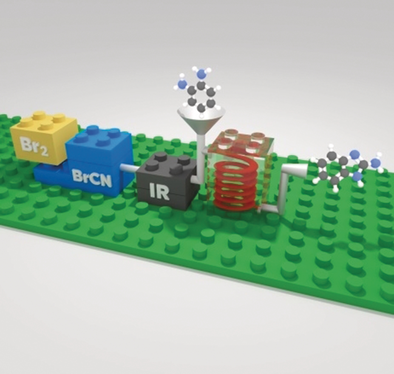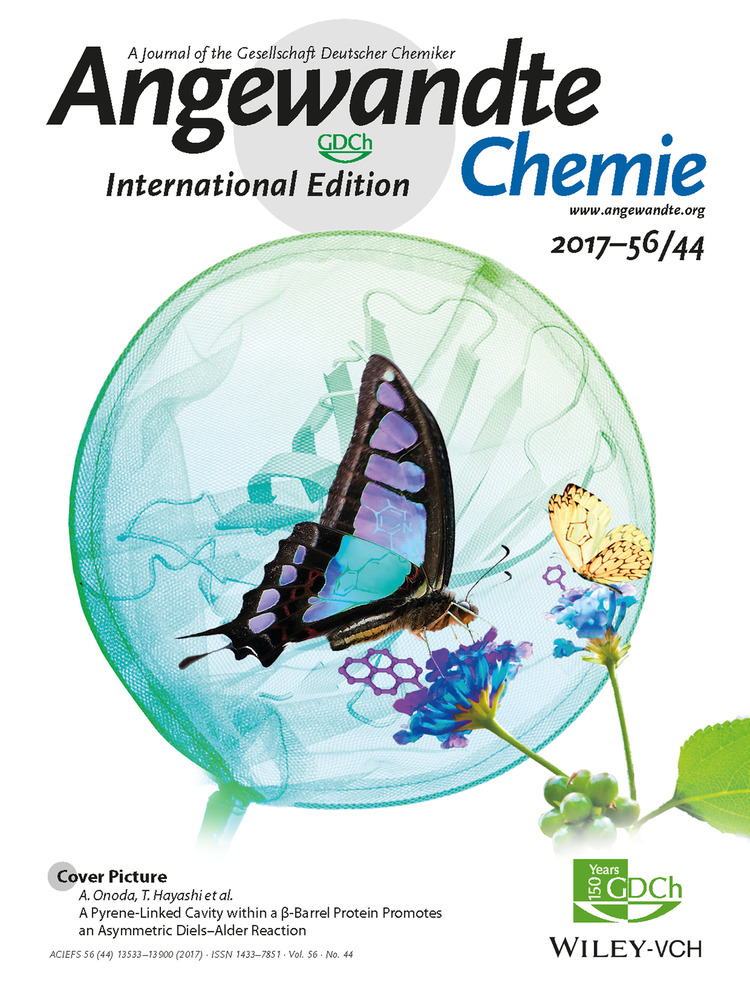Integration of Bromine and Cyanogen Bromide Generators for the Continuous-Flow Synthesis of Cyclic Guanidines
Gabriel Glotz
Center for Continuous Flow Synthesis and Processing (CC FLOW), Research Center Pharmaceutical Engineering GmbH (RCPE), Inffeldgasse 13, 8010 Graz, Austria
Institute of Chemistry, NAWI Graz, University of Graz, Heinrichstrasse 28, 8010 Graz, Austria
Search for more papers by this authorRené Lebl
Center for Continuous Flow Synthesis and Processing (CC FLOW), Research Center Pharmaceutical Engineering GmbH (RCPE), Inffeldgasse 13, 8010 Graz, Austria
Institute of Chemistry, NAWI Graz, University of Graz, Heinrichstrasse 28, 8010 Graz, Austria
Search for more papers by this authorDr. Doris Dallinger
Institute of Chemistry, NAWI Graz, University of Graz, Heinrichstrasse 28, 8010 Graz, Austria
Search for more papers by this authorCorresponding Author
Prof. Dr. C. Oliver Kappe
Center for Continuous Flow Synthesis and Processing (CC FLOW), Research Center Pharmaceutical Engineering GmbH (RCPE), Inffeldgasse 13, 8010 Graz, Austria
Institute of Chemistry, NAWI Graz, University of Graz, Heinrichstrasse 28, 8010 Graz, Austria
Search for more papers by this authorGabriel Glotz
Center for Continuous Flow Synthesis and Processing (CC FLOW), Research Center Pharmaceutical Engineering GmbH (RCPE), Inffeldgasse 13, 8010 Graz, Austria
Institute of Chemistry, NAWI Graz, University of Graz, Heinrichstrasse 28, 8010 Graz, Austria
Search for more papers by this authorRené Lebl
Center for Continuous Flow Synthesis and Processing (CC FLOW), Research Center Pharmaceutical Engineering GmbH (RCPE), Inffeldgasse 13, 8010 Graz, Austria
Institute of Chemistry, NAWI Graz, University of Graz, Heinrichstrasse 28, 8010 Graz, Austria
Search for more papers by this authorDr. Doris Dallinger
Institute of Chemistry, NAWI Graz, University of Graz, Heinrichstrasse 28, 8010 Graz, Austria
Search for more papers by this authorCorresponding Author
Prof. Dr. C. Oliver Kappe
Center for Continuous Flow Synthesis and Processing (CC FLOW), Research Center Pharmaceutical Engineering GmbH (RCPE), Inffeldgasse 13, 8010 Graz, Austria
Institute of Chemistry, NAWI Graz, University of Graz, Heinrichstrasse 28, 8010 Graz, Austria
Search for more papers by this authorGraphical Abstract
Abstract
A continuous-flow process for the in situ on-demand generation of cyanogen bromide (BrCN) from bromine and potassium cyanide that makes use of membrane-separation technology is described. In order to circumvent the handling, storage, and transportation of elemental bromine, a continuous bromine generator using bromate–bromide synproportionation can optionally be attached upstream. Monitoring and quantification of BrCN generation was enabled through the implementation of in-line FTIR technology. With the Br2 and BrCN generators connected in series, 0.2 mmol BrCN per minute was produced, which corresponds to a 0.8 m solution of BrCN in dichloromethane. The modular Br2/BrCN generator was employed for the synthesis of a diverse set of biologically relevant five- and six-membered cyclic amidines and guanidines. The set-up can either be operated in a fully integrated continuous format or, where reactive crystallization is beneficial, in semi-batch mode.
Supporting Information
As a service to our authors and readers, this journal provides supporting information supplied by the authors. Such materials are peer reviewed and may be re-organized for online delivery, but are not copy-edited or typeset. Technical support issues arising from supporting information (other than missing files) should be addressed to the authors.
| Filename | Description |
|---|---|
| anie201708533-sup-0001-misc_information.pdf5.3 MB | Supplementary |
Please note: The publisher is not responsible for the content or functionality of any supporting information supplied by the authors. Any queries (other than missing content) should be directed to the corresponding author for the article.
References
- 1
- 1aM. Movsisyan, E. I. P. Delbeke, J. K. E. T. Berton, C. Battilocchio, S. V. Ley, C. V. Stevens, Chem. Soc. Rev. 2016, 45, 4892–4928;
- 1bB. Gutmann, C. Cantillo, C. O. Kappe, Angew. Chem. Int. Ed. 2015, 54, 6688–6728; Angew. Chem. 2015, 127, 6788–6832;
- 1cN. Kockmann, P. Thenée, C. Fleischer-Trebes, G. Laudadioc, T. Noël, React. Chem. Eng. 2017, 2, 258–280.
- 2P. Poechlauer, S. Braune, B. Dielemans, B. Kaptein, R. Obermueller, M. Thathagar, Chim. Oggi/Chem. Today 2012, 30(4), 51–54.
- 3A. Singh, D.-H. Ko, N. Vishwakarma, S. Jang, K.-I. Min, D.-P. Kim, Nat. Commun. 2016, 7, 10741.
- 4Cl2:
- 4aF. J. Strauss, D. Cantillo, J. Guerra, C. O. Kappe, React. Chem. Eng. 2016, 1, 472–476;
- 4bT. Fukuyama, M. Tokizane, A. Matsui, I. Ryu, React. Chem. Eng. 2016, 1, 613–615;
- 4cY. Sharma, S. Moolya, R. A. Joshi, A. A. Kulkarni, React. Chem. Eng. 2017, 2, 304–308.
- 5
- 5aClN3: B. Leforestier, M. Vögtle, Synlett 2016, 27, 1957–1962;
- 5bBrN3: D. Cantillo, B. Gutmann, C. O. Kappe, Org. Biomol. Chem. 2016, 14, 853–857.
- 6CH2N2:
- 6aR. M. Maurya, C. P. Park, L. H. Lee, D.-P. Kim, Angew. Chem. Int. Ed. 2011, 50, 5952–5955; Angew. Chem. 2011, 123, 6074–6077;
- 6bF. Mastronardi, B. Gutmann, C. O. Kappe, Org. Lett. 2013, 15, 5590–5593;
- 6cD. Dallinger, V. D. Pinho, B. Gutmann, C. O. Kappe, J. Org. Chem. 2016, 81, 5814–5823.
- 7
- 7aN2CHCO2Et: R. A. Maurya, K.-I. Min, D.-P. Kim, Green Chem. 2014, 16, 116–120;
- 7bCF3CHN2: B. Pieber, C. O. Kappe, Org. Lett. 2016, 18, 1076–1079;
- 7cCHF2CHN2: J. Britton, T. F. Jamison, Angew. Chem. Int. Ed. 2017, 56, 8823–8827; Angew. Chem. 2017, 129, 8949–8953.
- 8HN3: B. Gutmann, J.-P. Roduit, D. Roberge, C. O. Kappe, Angew. Chem. Int. Ed. 2010, 49, 7101–7105; Angew. Chem. 2010, 122, 7255–7259.
- 9COCl2: S. Fuse, Y. Mifune, T. Takahashi, Angew. Chem. Int. Ed. 2014, 53, 851–855; Angew. Chem. 2014, 126, 870–874.
- 10V. Kumar, Synlett 2005, 1638–1639.
- 11J. Morris, L. Kovács, K. Ohe, e-EROS Encycl. Reagents Org. Synth. 2015, 1–12.
- 12D. N. Deaton, A. M. Hassell, R. B. McFadyen, A. B. Miller, L. R. Miller, L. M. Shewchuk, F. X. Tavares, D. H. Willard, L. L. Wright, Bioorg. Med. Chem. Lett. 2005, 15, 1815–1819.
- 13R. Frei, A. S. Breitbach, H. E. Blackwell, Angew. Chem. Int. Ed. 2012, 51, 5226–5229; Angew. Chem. 2012, 124, 5316–5319.
- 14D. Martin, M. Bauer, Org. Synth. 1983, 61, 35.
- 15
- 15aR. Scholl, F. Kačer, Ber. Dtsch. Chem. Ges. 1903, 36, 322–331;
- 15bP.-L. Compagnon, B. Grosjean, Synthesis 1976, 448–449;
- 15cK. Okamoto, M. Watanabe, M. Murai, R. Hatano, K. Ohe, Chem. Commun. 2012, 48, 3127–3129.
- 16H. A. Hageman, Org. React. 1953, 7, 198–262.
- 17A. Machara, M. A. A. Endoma-Arias, I. Císařová, D. P. Cox, T. Hudlicky, Eur. J. Org. Chem. 2016, 1500–1503.
- 18J. von Braun, P. Engelbertz, Ber. Dtsch. Chem. Ges. 1923, 56, 1573–1577.
- 19E. Gross, B. Witkop, J. Am. Chem. Soc. 1961, 83, 1510–1511.
- 20M. Murai, R. Hatano, S. Kitabata, K. Ohe, Chem. Commun. 2011, 47, 2375–2377.
- 21
- 21ahttps://www.cdc.gov/niosh/ipcsneng/neng0136.html, accessed: 17 August 2017;
- 21bW. E. Luttrell, J. Chem. Health Safety 2009, 16, 29–30.
- 22BrCN LCLo (lethal concentration low): 92 ppm/10 min inhalation, https://chem.nlm.nih.gov/chemidplus/rn/506-568-3, accessed: 17 August 2017.
- 23
- 23aW. W. Hartmann, E. E. Dreger, Org. Synth. 1931, 11, 30;
10.15227/orgsyn.011.0030 Google Scholar
- 23bO. Glemsner in Handbook of Preparative Inorganic Chemistry, Vol. 1, 2nd ed. ), Academic Press, New York, 1963, pp. 665–666.
- 24A. Adamo, P. L. Heider, N. Weeranoppanant, K. F. Jensen, Ind. Eng. Chem. Res. 2013, 52, 10802–10808.
- 25V. Sans, L. Cronin, Chem. Soc. Rev. 2016, 45, 2032–2043.
- 26J. M. Bell, M. L. Buckley, J. Am. Chem. Soc. 1912, 34, 14–15.
- 27F. Saczewski, Ł. Balewski, Expert Opin. Ther. Pat. 2009, 19, 1417–1448.
- 28D. A. Thaisrivongs, S. P. Miller, C. Molinaro, Q. Chen, Z. J. Song, L. Tan, L. Chen, W. Chen, A. Lekhal, S. K. Pulicare, Y. Xu, Org. Lett. 2016, 18, 5780–5783.
- 29B. P. Charrette, M. A. Boerneke, T. Hermann, ACS Chem. Biol. 2016, 11, 3263–3267.
- 30T. M. Wróbel, U. Kosikowska, A. A. Kaczor, S. Andrzejczuk, Z. Karczmarzyk, W. Wysocki, Z. Urbańczyk-Lipkowska, M. Morawiak, D. Matosiuk, Molecules 2015, 20, 14761–14776.
- 31https://www.cdc.gov/niosh/ipcsneng/neng0107.html, accessed: 17 August 2017.
- 32This method is often used in analytical chemistry and KBrO3-KBr mixtures of appropriate stoichiometry are commercially available: D. Diemente, J. Chem. Educ. 1991, 68, 932.
- 33D. S. Sholl, R. P. Lively, Nature 2016, 532, 435–437.





